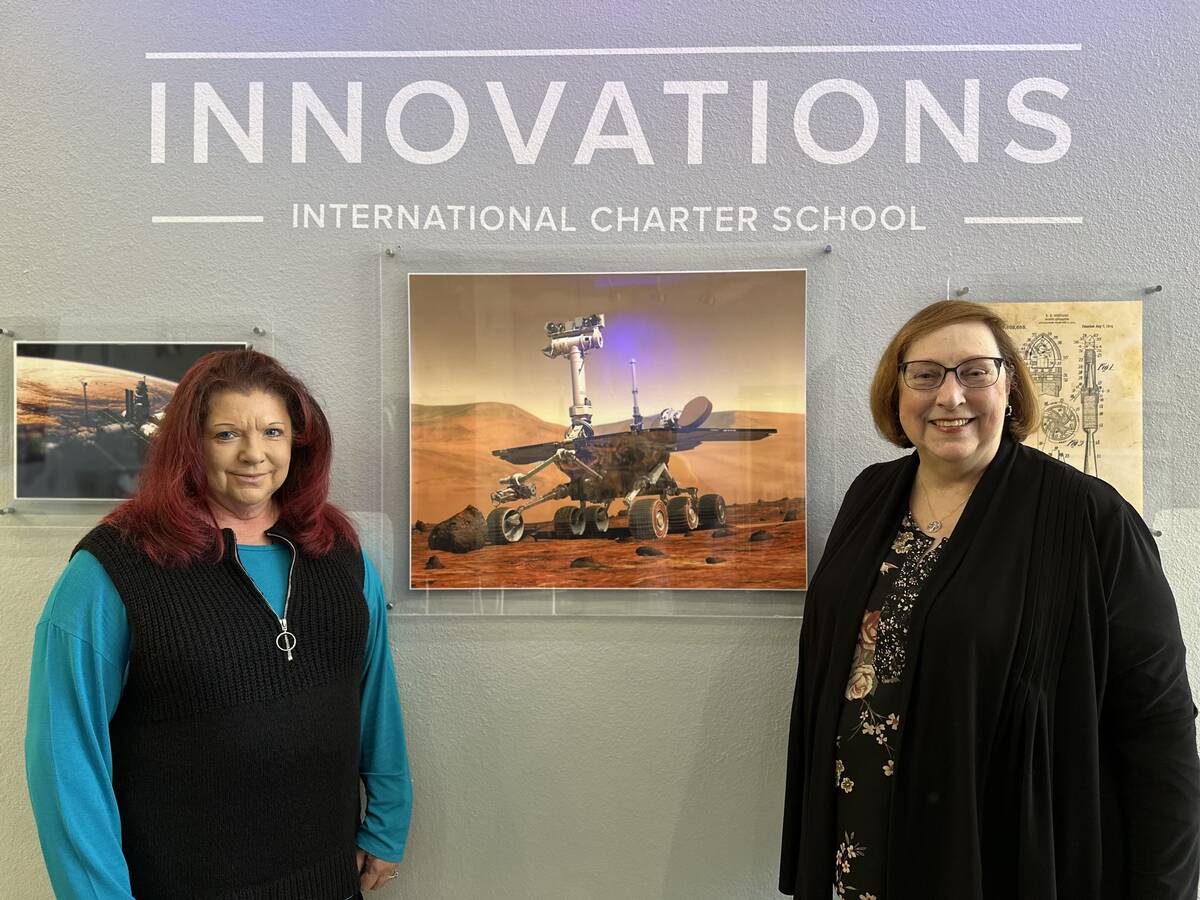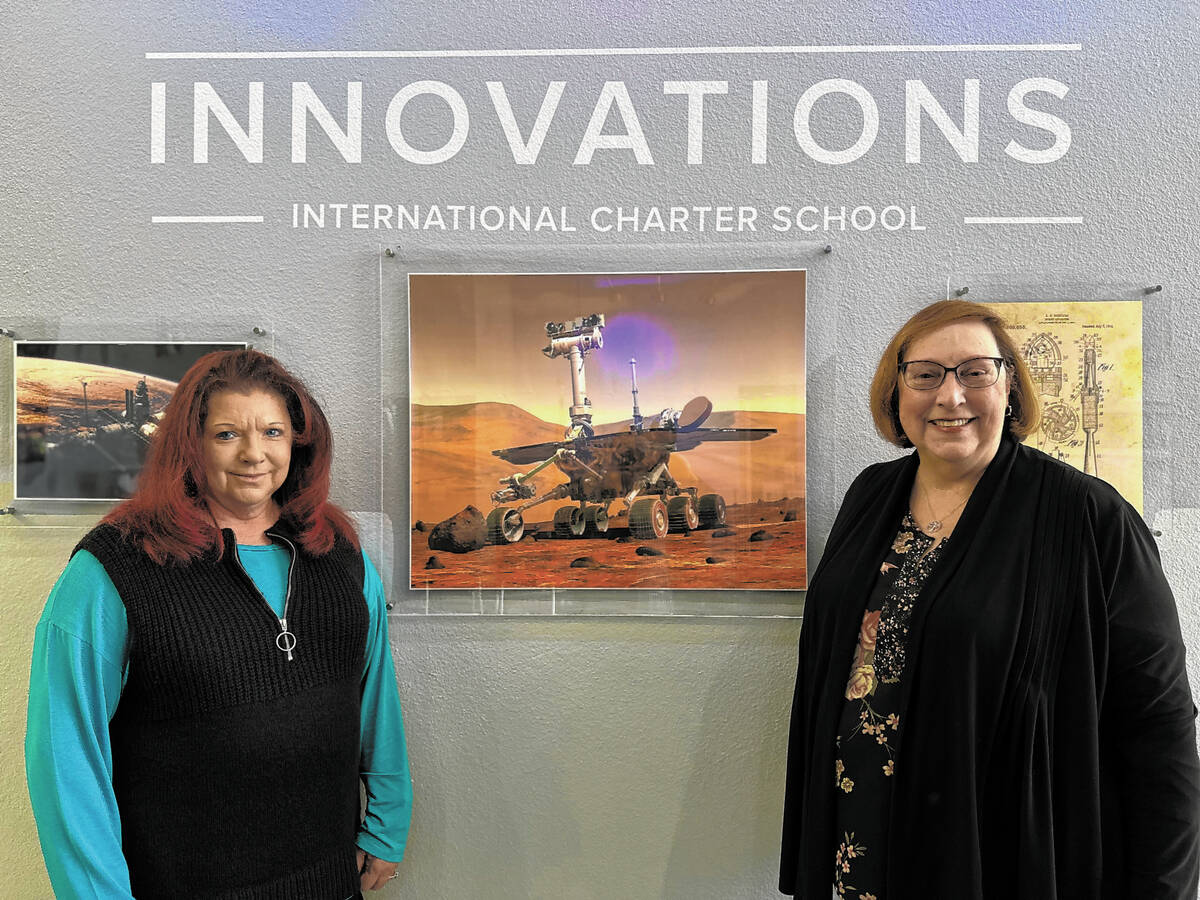Innovations International Charter School of Nevada is a family and community-oriented public charter school serving a highly diversified kindergarten through high school population.
Located in the shadow of The Stratosphere, IICSN serves approximately 400 students at the elementary school campus at 1600 E. Oakey Ave. It serves nearly 350 students in sixth through 12th grades on the City Impact Center Campus at 950 E. Sahara Ave. The classes range in size from 18-25 students per teacher.
The school opened in 2006 with a motto of “Educating for Life,” and currently is working toward a STEM accreditation at all levels. In addition, they offer wrap-around services for families to accommodate their before-and-after school needs. They hold family educational conferences in math, science and reading in which family members become learning partners with their children.
Dr. Connie Malin serves as the chief educational officer while Dr. LeAnn Putney is the president of the eight-person governing board.
Q: How did the charter school come about?
A: Putney: We both have background in education at the public-school level, and we met when I was a professor in the College of Education at UNLV. We completed writing the charter in 2005 along with the committee to form. Our vision of what a school could be relates to the entire family connection. We wanted to engage students in hands-on learning as much as possible. We wanted to make connections with bilingual children and their families as well. The premise of our school over the past 18 years has been providing a place we knew kids could thrive and learn. We rewrote the three Rs to be relevance, responsibility and relationship, and that underscores all that we do throughout the school.
Q: Why did you choose your location?
A: Malin: We wanted to serve at-risk populations of students and wanted to be centralized in the city. We have students in attendance at the school who represent 52 different ZIP codes. Parents are able to drop off their children at 6:30 in the morning for tutorial services and breakfast before school. The academic day goes from 8 a.m. to 4 p.m., and then we have an after-school program until 6 p.m., which includes dinner for those enrolled in the program. Children enrolled in the wrap-around programs receive breakfast, lunchand dinner daily at no cost to families.
Q: What about your location?
A: Malin: The reason we chose this location is because it is residential. Nearby are other schools, places of worship and small businesses. Because of the residential area the children feel that they are part of the community. Parents feel safer knowing their children are cared for when they leave them at school during the day and pick them up after work.
Q: Why the lengthy school day?
A: Malin:We calculated out that for every three years that students go to school with us, they have four years of education seat time because we have an extended school day. Many children may have limited pre-school experience so Innovations helps them develop literacy skills and language proficiency, and we provide them the extra time to help them with academic achievements.
Q: What is a charter school and how are you funded?
A: Putney: A charter school is a public school first and foremost. We are allotted the state and federal per-pupil funding and then to supplement we look for additional grant and donations. We were required to write, submit and get approval of a charter that outlines operational, financial and curricular procedures and focal points for the school. We wanted to make sure that we could have a school such that a family could bring all of their children at one stop. We wanted our school to be a central support system for local families.
Q: How does that work?
A: Malin: By law, charter schools offer a lottery system. At Innovations, once a grade level is full, additional names go onto a waiting list. If a position opens, we pull a lottery to fill that waiting list. Charter schools are public schools of choice. Each charter school finds a niche as something their community needs or something they are interested in that becomes a central theme. We follow the state mandates — the Nevada academic content standards and the testing mandates. Charter schools are afforded some autonomy in its governance. While we work with a state-adopted curriculum, we can supplement with other curriculum for programs we’re trying to develop.
Q: What about the oversight?
A: Putney: We are sponsored at this time by Clark County School District. We follow their mandates and have a liaison within the district we work through and are accountable to them. But organizationally, we work with our governing board for which I am president.
Q: What is the theme of the school?
A: Malin: Our theme has changed over the years to meet the needs of businesses and families. We currently are working toward becoming accredited for STEAM — Science, Technology, Engineering, Arts and Mathematics.
New jobs are going to involve technology and we have read that by 2026 our nation is going to be more than 600,000 positions short in the aviation field. Our high-school students have been taking electives in the aviation field in manned and unmanned planes. They have developed quite an interest in drones and artificial intelligence. We are looking at fields of interests where elementary students can build foundational skills toward a career path in secondary school. Our curriculum is highly science and technology based, from kindergarten all the way forward. Foundational courses at the elementary level focus on vocabulary, literacy, science, technology and math skills for an easier transition as kids move through programs preparing for high school graduation.
Q: How many teachers do you have?
A: Putney: We have approximately 60 teachers on both campuses, with an additional 25 support staff. We have a social worker, counselors and specialized student services. Because we are a Title 1 school, we use that funding to work with instructional coaches, academic strategists and tutors. We do anything we can to extend the learning for our students and supplement their learning to make academic achievement.
Q: Do students stick with your school?
A: Malin: We have about a 14 percent transiency rate, so students tend to stay with us for multiple years. Over the last three years, we have been graduating students who have been with us since kindergarten. We have former students who are now married adults who bring their children back to the school. We are a community-based school where people know that we are focused not only on the education of their children but on their safety as well. We provide community services and work with our parents and let them know we love having them in the building. We love working programs with them and coordinating services as much as we can.
Q: What about parental involvement?
A: Putney: Charter schools are schools of choice, and the parents are very engaged with what is happening in the building. They drop off and pick up their children every day, and they want to know what is going on. Because they chose us to educate their children, they are very excited to be a part of the community we are forming as a community of learners. The families are very engaged.
Q: How are students performing at your school?
A: Malin: We did really well prior to COVID, and we are on the uprise again and very solid. We’re seeing progress and hope to see significant progress again this year. We are still graduating a high number of our seniors. We have seniors who are accepting scholarships in universities across the U.S., and others enrolling in various branches of the military. We have been seeing high graduation rates overall.
Q: Why should parents choose your school?
A: Putney: We are very strategic in seeing what our students need and how they need to be connected with their teachers and with each other. We are purposeful in adding enrichment activities to the classroom. The idea of the school as a community is the main thing we have worked toward. Having kids feel like they belong helps them move forward in their academics.
Q: What changes have taken place?
A: Malin: Over the last few years, we diversified the technology base within the building. We work with three dimensional computers, and virtual reality glasses for enriching classes. The students are learning to do button and block coding, robotics and working with 3D printers. Our robotics team at the elementary school just placed ninth out of 210 teams this year in a robotics competition. They placed 21st the year before so they are making great progress. We have a flight simulator at the high school and drones that are being flown K through 12 with various activities. We have accepted a grant from Green Our Planet and students will be growing herbs and vegetables using hydroponics. This complements the outdoor Victory Garden that has been in place at the elementary school. We are seeing our students become highly proficient in technology to prepare them for jobs of the future.
Q: What do you do for sports?
A: Putney: We have sports at all levels for boys and girls, and next year we will be adding after school-clubs. We offer boys’ and girls’ basketball, girls’ volleyball and soccer at the high school. At elementary and middle school, we have the same sports, as well as flag football and coed soccer at elementary.
Q: How does enrollment work?
A: Malin: The lottery system is always in effect. Open enrollment begins every Feb. 1. We are enrolling now for the new school year. Once classes are full, a waiting list is generated. Whenever we have an opening, we call the parents on the list and say we are ready to pull the lottery and ask if they are still interested.
Q: How do you enroll?
A: Putney: Families can enroll their children through the website or come to the school and enroll them. They will be told whether they are in because we have room, or they go to the waiting list when the lottery is pulled.









